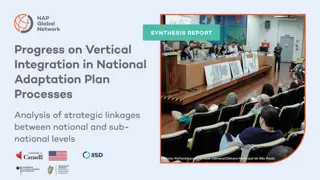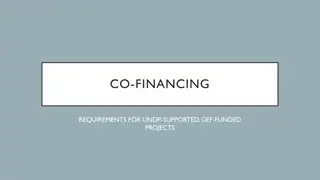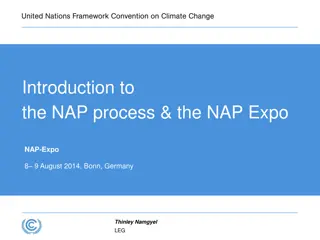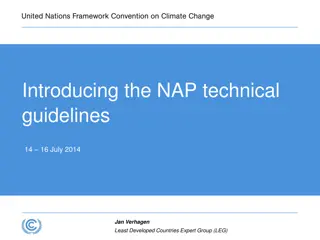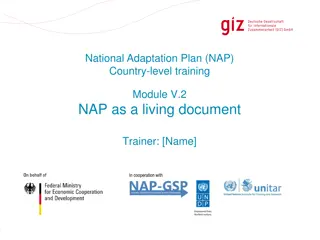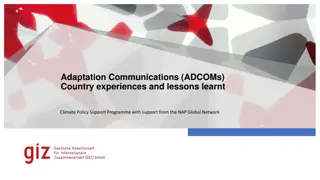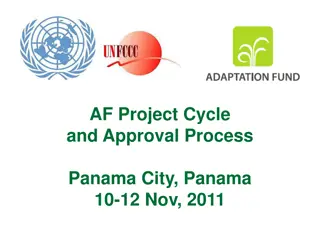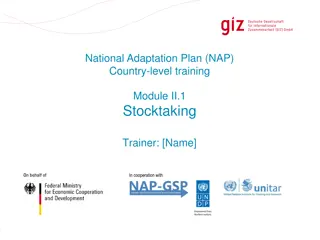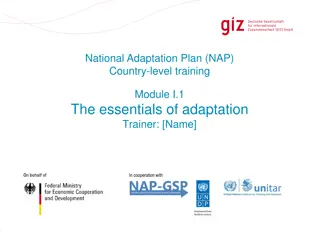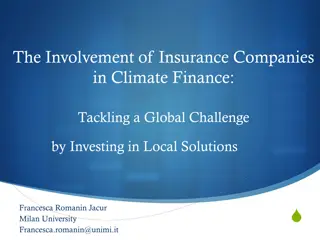Understanding Climate Financing for Adaptation: NAP Country-Level Training
Explore Module IV.2 on financing adaptation in National Adaptation Plans (NAP). Learn about tracking climate financing, determinants of financing strategies, potential funding sources, and activities that require funding for adaptation. Discover the Climate Public Expenditures and Institutional Review (CPEIR) as a tool for analyzing climate finance allocations. Gain insights into the sectors and activities that need to be financed for effective adaptation to climate change.
Download Presentation

Please find below an Image/Link to download the presentation.
The content on the website is provided AS IS for your information and personal use only. It may not be sold, licensed, or shared on other websites without obtaining consent from the author. Download presentation by click this link. If you encounter any issues during the download, it is possible that the publisher has removed the file from their server.
E N D
Presentation Transcript
National Adaptation Plan (NAP) Country-level training Module IV.2 Financing adaptation Trainer: [Name] In cooperation with Slide 1
Overview of this module Tracking climate financing for adaptation Determinants for strategies of financing Potential sources of finances and their relevance for LDC adaptation activities Slide 2
What can you expect to learn from this session? Get introduced to CPEIR as a tool for tracking climate finance. Understand options and relevance of domestic and international climate financing. Slide 3
Tracking existing financing of climate change activities: The Climate Public Expenditures and Institutional Review (CPEIR) Background: Often weak consolidation of climate change activities on a national level (also due to the lack of consolidation of funding streams on international level) CPEIR offers an analysis of allocation and management of public expenditures for climate change. Analysis of current climate expenditures from both domestic (including classification of budgets) and external sources of finance. Advantage: CPEIRs have already played an important role in stimulating more comprehensive and inclusive reflections on climate change in the countries applied. Disadvantage: Very work intensive process. 13/09/2024 Slide 4 NAP country-level training
What needs to be financed in adaptation? Sector Enabling activities Policy and legislation Agriculture Energy Example activities Supporting the development of climate change adaptation-specific policies, programs and plans Capacity strengthening of national institutions responsible for adaptation Promoting diversified agricultural production to reduce climate risk Strengthening of energy transmission and distribution infrastructure to cope with the expected impacts of climate change Strengthening food safety regulations; developing or enhancing monitoring systems Building protection from climate hazards into existing transport infrastructures (e.g. Disaster Risk Reduction measures) Health Transport Water and sanitation Monitoring and management of hydrological and meteorological data 13/09/2024 Slide 5 NAP country-level training
Typical sources for financing adaptation Source: UN-MPTF, 2014 Slide 6
Example Bangladesh: Relevance of funding sources and channels 13/09/2024 Slide 7 NAP country-level training
Examples for domestic sources Regular national budget Regular local budget Targeted transfers from national to local budgets National Climate Fund Commercial / concessional loans Private investments Fees/charges Insurance systems Public Private Partnership Slide 8
Multilateral / bilateral funds UNFCCC Green Climate Fund (GCF) Adaptation Fund (AF) Least Developed Countries Fund (LDCF) Special Climate Change Fund (SCCF) Multilateral institutions Pilot Program for Climate Resilience (PPCR) German ICI UK International Climate Fund Bilateral funds Slide 9
Current trends in international / public climate financing DFI = Development Finance Institutions Out of this: adaptation is only a small share (appr. 7.5 %) in 2013 Source: Climate Policy Initiative 2014: The Global Landscape of Climate Finance 2014 13/09/2024 Slide 10
Adaptation Fund (AF) Objective: To support concrete adaptation activities that reduce the adverse effects of climate change facing communities, countries, and sectors Countries eligible: Developing country parties to the Kyoto Protocol particularly vulnerable to the adverse effects of climate change. Access modalities: Direct, regional and multilateral access Project size: Small size (requesting up to $1 million) & Regular size (> $1million) Cap for maximum amount of funding per country at US$ 10 Million Project application process: Throughout the year on a rolling basis 11 Slide 11 Source: Adaptation Fund Operational Policies and Guidelines https://www.adaptation-fund.org/
Pilot Programmes for Climate Resilience (PPCR) The largest international source for adaptation finance Objective: To provide programmatic finance for climate resilient national development plans Countries eligible: Priority to highly vulnerable least developed countries Access modalities: Multilateral Development Bank (MDB) Focal Points (AfDB, ADB, EBRD, IDB, IFC, WB) Actions supported: e.g.: Building climate-resilient agricultural practices, water supply, monitoring and analyzing weather/ climate data support should build on existing NAPAs Instruments: Grants and concessional finance 13/09/2024 Slide 12 NAP country-level training
Least Developed Countries Fund (LDCF) Countries eligible: Least Developed Countries (LDCs) Actions supported: Preparation and implementation of National Adaptation Programs of Action (NAPAs) by least developed countries (LDCs) Preparation of the National Adaptation Plan (NAP) process Project size: Full-sized Projects (> $2m) Medium-sized Projects (< $2m) Instruments: Grants Institutions involved: GEF Operational focal point GEF Agencies 13/09/2024 Slide 13 NAP country-level training
Special Climate Change Fund (SCCF) Countries eligible: All non-Annex 1 countries; Priority to the most vulnerable countries in Africa, Asia, and the Small Island Developing States (SIDS) Actions supported: Adaptation (SCCF-A) including preparation activities for the National Adaptation Plan (NAP) process Transfer of technologies (SCCF-B) Project size: Full-sized Projects (> $1m) Medium-sized Projects (< $1m) Instruments: Grants Institutions involved: Similar process as for LDCF 13/09/2024 Slide 14 NAP country-level training
Green Climate Fund (GCF) Countries eligible: Developing countries Actions supported: Mitigation (50%) and Adaptation (50%) including supporting developing countries in pursuing project-based and programmatic approaches, such as NAPs. a floor of 50% of the adaptation allocation for particularly vulnerable countries, including least developed countries (LDCs), small island developed States (SIDS) and African States Access modalities: Direct, Regional and International access Specialty: Expected to become the main global fund for climate finance first project financing foreseen in 2015 Source: (GCF/B.06/07, p.4) http://www.gcfund.org/ 13/09/2024 Slide 15 NAP country-level training
Case Work Analysis of 3 cases of relevance to the country of application in respect to: Classificiation of adaptation options along CPEIR methodology Identification of potential financing sources. 13/09/2024 Slide 16 NAP country-level training
Imprint Published by Deutsche Gesellschaft f r Internationale Zusammenarbeit (GIZ) GmbH This presentation is part of a NAP country-level training that has been developed by GIZ on behalf of BMZ and in cooperation with the NAP Global Support Programme (NAP-GSP), in particular UNDP and UNITAR. Climate Policy Support Project Dag-Hammarskj ld-Weg 1-5 65760 Eschborn, Germany T +49 61 96 79-0 F +49 61 96 79-1115 The training is designed to support countries in setting up a National Adaptation Plan (NAP) process. It builds on the NAP Technical Guidelines developed by the Least- Developed Countries Expert Group (LEG). Contact E climate@giz.de I www.giz.de/climate You are welcome to use the slides, as long as you do not alter its content or design (including the logos), nor this imprint. If you have any questions regarding the training, please contact Till Below or Nele B nner at GIZ. For questions related to the Technical Guidelines, please refer to the UNFCCC s NAP Support Portal. Responsible Till Below and Nele B nner, GIZ Authors Alfred Eberhardt As a federally owned enterprise, the Deutsche Gesellschaft f r Internationale Zusammenarbeit (GIZ) GmbH supports the German Government in achieving its objectives in the field of international cooperation for sustainable development. GIZ also engages in human resource development, advanced training and dialogue. Slide 17



